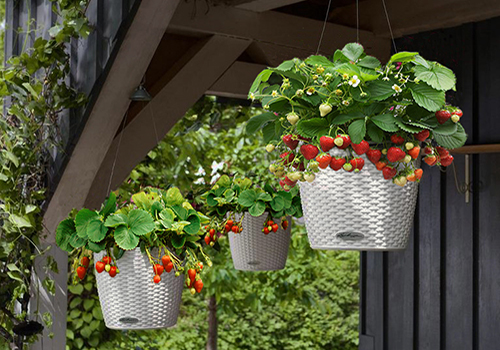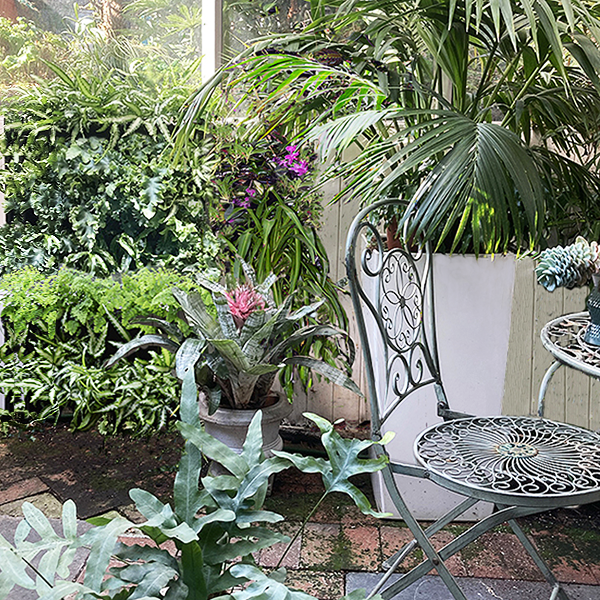The Ultimate Guide to Container Gardening
No space, no problem.
Container gardening is ideal for those with little or no garden space. In addition to growing flowers, gardeners limited to a balcony, small garden, or only a patch of sun on their driveway can produce a wide variety of vegetable crops in containers. Basil, chives, thyme, and other herbs also are quite happy growing in pots, which can be set in a convenient spot right outside the kitchen door.
This type of gardening is also an easy way to introduce children to the joys and rewards of gardening.
From raised beds to self watering planters and living walls, container gardening offers a number of benefits. If you are new to this type of gardening, or have had limited success, here are a few tips to help you succeed.
Drainage
Just about any container can be used, but the most important thing to consider is drainage. There should be a minimum 2 cm hole for every square foot of soil surface.
Plants will not grow successfully in compost that is continually waterlogged. Do not put anything (e.g. rocks, broken pot pieces, etc.) in the bottom of the pot as layering materials in a container actually impedes drainage. Water moves best through a continuous column of soil mix.
Watering
Making sure your plants are watered correctly is essential to container gardening success. Roots need a balance of air and water to grow well which is easy to provide if you have a good quality compost.
Plants can easily drown if the compost is too wet as there will not be enough air and plants will often benefit if the compost is allowed to dry a little between waterings. A effective technique to test if your plants need water is to push your index finger into the soil up to your second knuckle. If it is cool and damp, hold off — if it is dry, then it's time to water.
It's best to water thoroughly, and less often, rather than giving a daily sprinkling. Most herbs grow well when allowed to dry between watering since this reduces the chances of root rot.
Self-watering planters are a great option for those who want to take all the guesswork out of watering. They ensure that plants are never under- or over- watered, giving plants the optimum amount of water that they really need to thrive. They are also a great option for those who travel frequently or forget to water as they have interior reservoirs that'll provide plants with water for weeks.
For more information about watering plants in containers, we recommend the RHS Watering Plants in Containers Guide for a comprehensive overview.
Don't use the same Compost for Everything
We don't recommend using the soil from the ground. Compost is soilless and therefore sterile, free of fungus, disease and weed seeds, holds moisture and nutrients but drains well and is lightweight. Plants in containers—especially edible plants—need lots of nutrition, aeration, drainage, and moisture retention, and you'll get all these qualities with a good, all purpose compost from your local garden centre.
The all-purpose kind is fine for most plants, but do your research. Some require more drainage than a standard compost can provide or an especially high or low pH. Succulents, for example, need a special cactus mix whereas ferns benefit from the high drainage provided by tropical compost.
Although it's very frustrating, we do not recommend re-using compost. The nutrients will have been used up, and the only thing that might remain in it are root-bound diseases spores, which you do not want to pass over. However, if you have a garden or know someone who has, do not throw last year’s compost out, you can put it there.
Which Plants to Choose
Ask yourself, “What am I trying to achieve?” A potted wildlife garden containing bee balm, echinacea, and marigold will attract beneficial insects and butterflies.
If you just want colour, look for plants that suit the sun and wind exposure of your container garden's location. It sounds simple but it is surprising how often people get this wrong.
For a low maintenance garden requiring minimal watering, you could include drought-tolerant plants like pelargoniums, nicotiana, geraniums, lavender, verbena, cosmos and sage and rosemary.
If you want to grow your own food, like a tomatoes, give it enough space and sunlight to perform. A tomato plant will need two bushels of compost to thrive, which is more than most people realise.
If you want to grow vegetables in containers, tomatoes are among the easiest vegetables to grow in containers, provided your balcony gets five to six hours of sunlight a day. If you're tight on space, look for dwarf varieties, such as cherry tomatoes.
Beans are perform well in container gardens. Position them in a spot that gets lots of sun, a container at least one foot deep and a trellislike structure for the beans’ vines to grow.
Peppers, particularly smaller varieties such as chili or jalapeno, perform well in containers, but they require be a large, deep pot. Give it full sun and fertilise from when the plant flowers until it’s done producing peppers.
Best Container Types
So of course, you need a vessel or a pot to contain your plants. Choices for containers are almost endless but generally, the larger the container, the happier the plants as small container can dry out really quickly.
Do your research and find out how big the root ball is going to get so that you don’t have to keep up-potting to bigger pots.
Better to get it right on the first time around.
As already mentioned, just remember that a really key feature is to make sure they have drainage holes a the bottom.
Here is a list of our favourite types of containers that will help you get the most out of your container garden:
Terracotta Planters
Terracotta planters are our favourite type of material for container gardening.
The high density of the clay makes the pots frost resistant.
They are also porous which allows air to flow through to the roots, whilst retaining moisture. This will give your plants the optimum growth conditions they need to thrive and help prevent soil disease and root rot.
Hanging Baskets
You could try planting hanging baskets with lettuce, salad greens, or herbs. The only disadvantage is that once you cut some of the lettuce, the basket can look a little bare. One way around this is to keep seedlings always sprouting to replace what you've eaten.
Also, if you opt for coir hanging baskets, this material tends to dry out quickly—on a windy day, a warm breeze can suck the moisture right out of the compost. To help prevent this from happening, line coir baskets with plastic and check them daily, to find out if they need watering. It's also a good idea to give a basket like this some shade mid-day when it's really hot.
Wooden Planters
Wooden planters are among the best choices for growing vegetables in containers.
They’re attractive, they come in all sizes, and they’re durable, blend into many garden schemes, and are relatively cheap.
Vegetables grown in wooden planters are often healthier than vegetables grown in planters of the same size.
Their roots stay cooler and have room to grow and spread out through the whole box.
Wood doesn’t heat up as much as plastic or ceramic pots, so wooden planters work well in hot conditions.
They’re heavier than plastic, but lighter than ceramics. Their rectangular or square shape also helps retain soil moisture.
You can make them last longer if you line them with plastic sheeting such as a pond liner and puncture it to allow drainage.
Our preferred choice of wood is sustainably sourced Larch as this type of wood is naturally resistant to decay and very long lasting.
Grow Vertically
If you're tight on space, vertical is the way to go! Imagine a veritable jungle of living, breathing life-enhancing richness.
Growing vertically is the ultimate way to make the most out of a small spaces.
Many different types of houseplants, annuals, perennials, and shrubs work well in a vertical space, so you're not limited on what plants you can use.
Take a look at our ultimate guide to the best plants for vertical gardens.
Your name *












